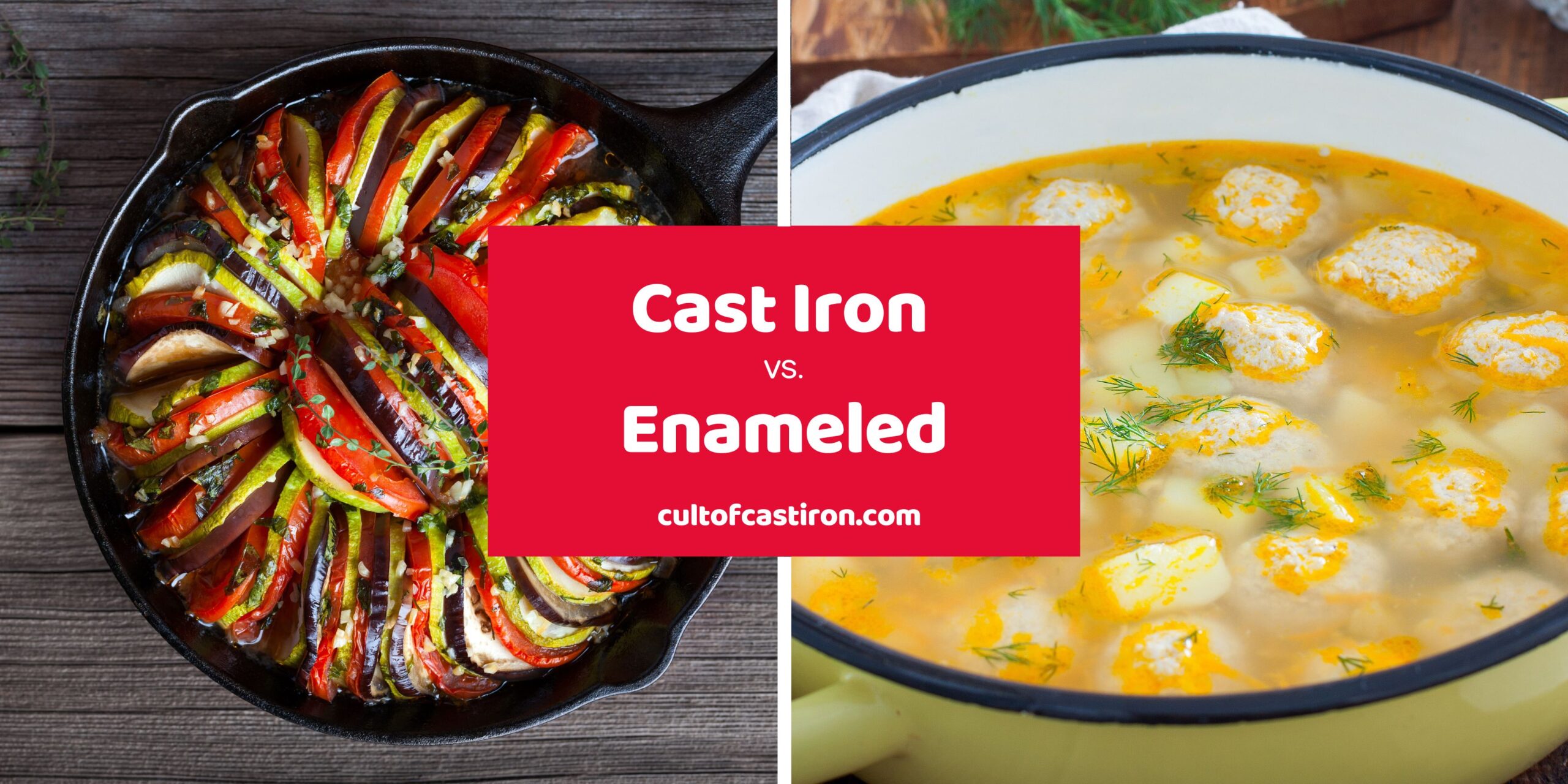If you’re looking for a new piece of cookware that can handle high heat, last for decades, and add some flavor to your food, you might be considering cast iron. But did you know that there are other types of cast iron cookware?
For one, there’s the regular, bare cast iron — the classic black skillet you might have seen in your grandma’s kitchen. Then, you might’ve heard of enameled cast iron, which has a colorful and glossy coating that covers the metal.
Both types of cast iron cookware have their pros and cons, but the ultimate question stands: which one is better for home cooks?
Read on as we compare cast iron vs. enameled cast iron cookware on various aspects like performance, durability, price, and more, and help you choose which one suits your needs and preferences!
Cast Iron vs. Enameled Cast Iron Cookware
While choosing between a regular cast iron and an enameled cast iron cookware all boils down to your personal preferences and priorities, here’s a handy guide that explores their differences, helping you make the perfect decision for the next addition to your kitchen.
Buckle up and get ready to dive into the difference between cast iron and enameled cast iron, considering all the criteria that matter most to you!
- Heat conduction, retention, and distribution
- Durability
- Weight
- Non-stick quality
- Versatility
- Maintenance
- Aesthetics
- Price
1. Heat conduction, retention, and distribution
Cast iron and enameled cast iron have different abilities in conducting and holding heat. Check out the table below to see how they compare with other metals in terms of conductivity values.
| Material | Thermal Conductivity (W/mK) |
| Copper | 386 |
| Aluminum | 239 |
| Cast Iron | 55 |
| Carbon Steel | 45 |
| Stainless Steel | 25 |
| Porcelain | 1.5 |
Now, when it comes to heat, both cast iron and enameled cast iron play in the same league as they are essentially made from the same base material. Both types of cookware are excellent at conducting, retaining, and distributing heat evenly.
The enamel coating is not thick enough to affect the heat properties of the cast iron significantly. However, because enamel doesn’t conduct heat quite as well as a solid cast iron pan, enameled cookware can heat up a little more slowly than regular cast iron pans.
2. Durability
In terms of durability, regular cast iron wins. Bare cast iron can last a lifetime if properly cleaned and maintained. It can withstand high temperatures, open flames, and metal utensils without damage.
Enameled cast iron, on the other hand, is prone to chipping and cracking if dropped or poked with metal utensils. It can also break with thermal shock, which happens when the cookware is exposed to sudden temperature changes. Basically. As heated cast iron expands, splashing it with cold water can make it contract quickly. The enamel coating that sits atop the metal may not react as quickly, which may cause it to crack.
However, the enamel does protect the cast iron from rusting better than traditional seasoning.
3. Weight
Both cast iron and enameled cast iron are heavyweights in the kitchen, literally and figuratively. They have a similar heft that can help you tone your arms while cooking. However, they can be significantly harder to maneuver around the kitchen compared to other types of cookware. Also, you may find it quite straining to do cooking techniques like stir-frying and tossing with these solid blocks of iron. So whether you’re weighing your options or stepping onto the scale, it’s a draw between these two types of cookware.
4. Non-stick quality
When it comes to non-stick capabilities, bare cast iron beats its enameled counterpart. Regular cast iron develops a natural non-stick surface when properly seasoned, making cooking delicate foods like eggs or pancakes easy.
Meanwhile, an enameled cast iron pan does not have the same layer of polymerized oil that graces the surface of bare cast iron, which means it loses its non-stick qualities. I’d say that it has the same stickiness as a stainless steel pan, so you’d better use more oil (that is properly preheated) before cooking to prevent a sticky situation from ensuing.
5. Versatility
Versatility is another aspect that can distinguish the difference between cast iron and enameled cast iron. Among the two, bare cast iron is more versatile as it can go on the stove, in the oven, and on an open fire, making it ideal for any form of cooking—searing, frying, baking, roasting, grilling, you name it!
Now, while an enameled cast iron can go on the stove and in the oven, open fires may be too hot, which can actually induce thermal shock and damage the enamel. The cookware prefers a more controlled environment with low to medium heat and moisture. Sauces, soups, stews, braises, and casseroles are just a few that could work well with this type of cast iron.
6. Maintenance
Prepare for the ease of maintenance, as enameled cast iron takes this round. With its smooth surface, enameled cast iron does not need to be seasoned and can be washed with warm soapy water without affecting its performance.
Regular cast iron is high-maintenance in the sense that it needs to be seasoned before and throughout its use to prevent rusting and maintain its non-stick quality. Additionally, it cannot be washed with soap or left wet as it can damage the seasoning layer.
7. Aesthetics
Let’s now indulge in the beauty of cookware, shall we? When it comes to aesthetics, enameled cast iron undoubtedly takes the crown. This cookware often comes in bright and striking colors that can add some flair to your kitchen or table.
On the other hand, traditional cast iron has a dull black or dark gray color that may not appeal to everyone. While it surely exudes timeless elegance with its raw and rugged exterior, it evokes more of a sense of nostalgia for the culinary traditions of the old, which may not be enticing to most home cooks, particularly the young.
Think of it like this: enameled cast iron is like a fashionista who always dresses up for any occasion. Bare cast iron is the minimalist who prefers simplicity over style.
8. Price
Lastly, it’s time to talk about the price tag. While it generally depends on the brand and size of the pan you’re going for, bare cast iron skillets are the more affordable option overall.
With its glossy finish and added benefits, enameled cast iron cookware often come with a higher price tag. It can cost three to four times more than its counterpart, all for its enamel-glazed properties that require more materials and added steps in production.
Meanwhile, traditional cast iron, being a sturdy workhorse, proves to be a more economical choice for the frugal chef without compromising on quality.
The Final Verdict: Which Type of Cast Iron is Right for You?
If you’re wondering about cast iron vs. enameled cast iron, you’re not alone. Many home cooks face this dilemma when choosing the best cookware for their kitchen.
Ultimately, the best type of cookware for you depends on your personal needs and preferences. You might even want to have both types of cast iron in your kitchen arsenal, so you can enjoy the best of both worlds!
If you want to learn more about cast iron and other cookware, check out more blogs from the Cult of Cast Iron for helpful tips, tricks, and insights. You’ll find everything you need to know about how to choose, use, and care for your cast iron cookware and more.
Follow the Cult of Cast Iron today and discover the joys of cooking with this amazing material! Happy cooking!

Miguel is a cast iron enthusiast from Cavite, Philippines. He works in the digital marketing field as a content marketing strategist. On the side, he manages a small online bookstore and tends to his plants.


